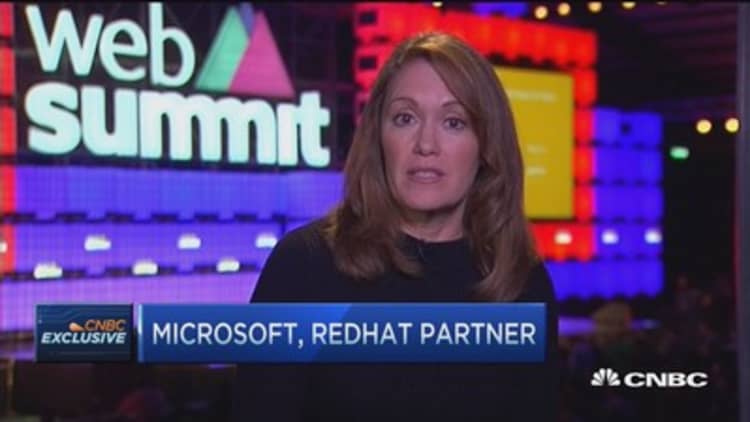It's been a tough year for enterprise technology, with investors dumping shares of companies that are struggling to win in the cloud.
Quietly bucking the trend is a name that will likely surprise you: Red Hat.
The open source software pioneer is riding the transition away from proprietary systems and toward commodity hardware and more open, agile development. The stock has surged 29 percent in the past year, topping every legacy U.S. enterprise tech company.
IBM, Oracle and Intel are all down over the past 12 months, while Microsoft is up 12 percent and Cisco has gained 2.9 percent, as of Thursday's close. Red Hat's performance is almost in line with cloud software vendors Salesforce.com and Workday, which have both jumped over 30 percent.
Red Hat, a 22-year-old software developer based in Raleigh, North Carolina, is the rare tech company that's been able to steadily grow over the past decade without suffering much profitability. Its gross margin, or what's left of revenue after subtracting costs of goods sold, is a robust 84 percent.
The core of Red Hat's business is the commercialization of Linux, an open source operating system that competes with Microsoft Windows. Now, with application development and cloud deployment turning to open source, Red Hat has a number of new ways to make money, and chief information officers are taking note.
How Red Hat stacks up
"Open source is much cheaper, much more flexible and agile, so a lot of large enterprise accounts are focused on what we're doing," Red Hat CFO Frank Calderoni said in an interview with CNBC.com earlier this week. "We're starting to get more on the radar as it relates to enterprise CIOs."
Calderoni joined Red Hat in June and was previously finance chief at Cisco.
Giant businesses like Barclays and DreamWorks are using Red Hat's Linux technology for application development while others including Volvo and Target are counting on its infrastructure tools as they move to the cloud.
Read MoreDocker's rise from sleeper to open source king
Investors haven't always been so bullish. Turning free products into paid offerings is inherently challenging, and there were questions about Red Hat's growth prospects. The stock was flat from mid-2012 to mid-2014.
Pacific Crest Securities analyst Ben McFadden is still cautious and says the rally may have gotten ahead of itself. Even with the move to the cloud, much of Red Hat's business remains in the traditional on-premise world, and investing in newer businesses is costly. He has a neutral rating on the stock.
"Shares have appreciated significantly and investments in the emerging portfolio of the business are likely to limit operating-margin expansion," McFadden wrote in a report last month. "The company is transitioning to a more diversified revenue stream, but it will take time."
Microsoft partners with Red Hat

The emerging business piece represents about one-third of overall revenue and is growing at a 40 percent to 50 percent clip. Calderoni says the company is picking up market share from proprietary vendors like IBM. It scored a huge victory this month when Microsoft said it would promote Red Hat's enterprise Linux product in the Azure cloud.
The deal is the latest example of Microsoft opening up its ecosystem to a longtime rival.
"We view this partnership as analogous to Darth Vader and Luke Skywalker joining forces," Drexel Hamilton analyst Brian White wrote in a Nov. 4 report. White has a buy rating on the stock and a $90 price target, 11 percent above the closing price on Thursday.
Red Hat is aggressively staffing up for growth, with sales increasing about 20 percent on a constant currency basis. Including currency fluctuations, analysts are projecting fiscal 2015 revenue of $2.04 billion, up 14 percent from a year earlier, according to Thomson Reuters.
Calderoni said the company has about 8,000 employees and is hiring 400 to 500 a quarter to develop and sell new products and bulk up in new geographic markets. That includes going after parts of U.S., Asia, Eastern Europe and Latin America.
"We're at a fairly rapid expansion rate," he said.




